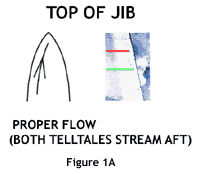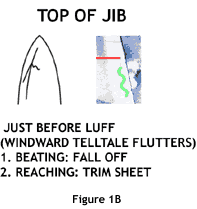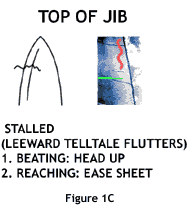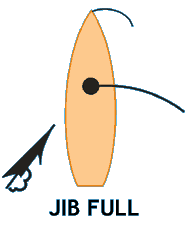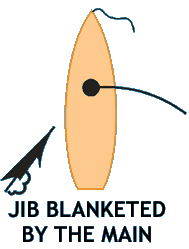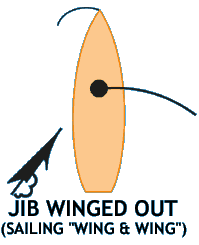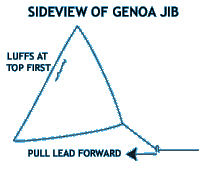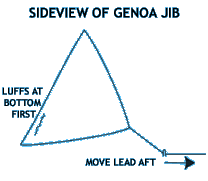VEGA SAILING SCHOOL
[Previous Chapter] [Next Chapter]
To sail well, we must allow for the shifts in the true and apparent wind while maintaining the optimum drive angle of the wind to the sails through judicious helmsmanship and proper sail trim. By imagining the air flowing past the sails as smoke, one can get a much better idea of proper sail trim. Many wind tunnel tests (called "smoke visualization tests") have been done with smoke blowing past sails. The difference between smooth flow and turbulent flow is very easy to see. Obviously we can't create a smoke screen in front of our sailboat, but we can do the next best thing: attach telltales to the sails so they indicate whether the flow past the sail is turbulent or smooth. Although telltales are less effective on mainsails, they have been very successful at indicating turbulence on jibs. The most practical method to attach telltales is to thread a needle with some light wool of a highly visible color and pass it through the sail. Cut it off leaving about five inches to hang out on either side of the sail and tie two small overhand knots right next to the sailcloth so the wool won't pull through. By using a long piece of wool, pulling it right through to five inches from the end, and cutting it off five inches from the cloth, you can repeat the process at other points on the sail without having to rethread the needle. Another good practice is to place the wool higher on one side of the sail than on the other. In certain sunlight conditions it's hard to tell which piece of wool is which, unless they are at different levels. Some people place tape on either side of the sail in fear that the needle hole will weaken the material, but the edges of the tape tend to loosen and the wool hangs up on them and on its adhesive. Eventually the tape comes off anyway, so it's best not to use it in the first place. The telltales should be placed in three positions along the luff of the jib about six to 12 inches from the leading edge depending on the size of the boat. Make sure that the wool cannot touch a seam or any sail stitching, because the hairs of the wool will catch on anything rough. The best telltales come from a type of wool that has as few tiny hairs as possible. Though Angora wool makes the best shroud telltales because of its mass-to-weight ratio (it's very light and fuzzy), it is definitely not the type to use next to a sailcloth on which the fuzz gets caught.
Now watch the middle set of telltales on the jib as you change your heading without varying your jib trim. In Figures 1A and 1B, you will notice that as the boat heads up toward the wind, the windward telltales will start to flutter. Conversely, when the boat heads too far off the wind, as in Figure 1C, the leeward telltale flutters because the angle of incidence (angle of attack) becomes so great that the wind is hitting mostly on the windward side of the sail. This disrupts the flow over the lee side and causes turbulence. To the sailor, this turbulence is the most important aspect indicated by telltales. If there is turbulence on the lee side, the sail, as an airfoil, is stalled and thereby does not produce the desired drive. Again, a luff is easy to see because the sail starts to flutter, but a stall is subtler. We've said before that the greater the angle of attack, the greater the drive until separation begins. With the jib telltales described (plus a few others farther back on the sail), we can trim the jib until the leeward telltales start to flutter. You'll find it's a very fine line between a luff and a stall, probably a five to 10-degree change in heading or angle of attack.
Telltales are very helpful for the beginner and yet can be used to advantage by the expert. The sailor who is learning to sail to windward by using these telltales may use a very simple rule (dubbed "Reinhorn's Law" in honor of Dr. Reinhorn—an Offshore Sailing School student of 1967). The rule reads: "Point the tiller at the fluttering piece of wool." If the leeward wool is fluttering, it's because the boat is being sailed too low, too far away from the wind for the desired close-hauled course, and should be pointed more toward the wind—putting the tiller to leeward cures this. If the windward piece of wool is fluttering the boat is being sailed too close to the wind on the verge of a luff—putting the tiller to windward causes the boat to fall off and solves the problem. One of the mistakes that many skippers make is trying to keep the telltales flowing on both sides all the time. There are many conditions when this shouldn't be done. For instance, in a strong wind and smooth sea you may be able to pinch (carry a very slight luff in the jib) and still maintain your speed or even go faster. The windward wool will flutter. If you fall off until both sides flow evenly, excessive heeling reduces the speed of the boat. So the experienced helmsman takes the wool on the jib with a grain of salt and steers what he feels to be the fastest course for the existing conditions. There are two conditions when the jib telltales really come into their own. The first is reaching. While racing, the jib should be "played" constantly on a reach. This means crew members must ease it when it stalls and trim it when it luffs. They should have their eyes glued to the telltales near the luff of the sail and the jib sheet in hand whether sailing a small boat or a maxi yacht. Without the wool on the jib it is very, very difficult to determine if the sail is stalled.
As with everything else about sailing, there are exceptions. When the reach becomes very broad and approaches a run, there is a transition, in simplest terms, from "pull" to "push." Instead of wind flow over the lee side of the sail we have strictly "drag." The sail form that creates the most drag will push the boat fastest. Though we want to retain aerodynamic flow over the lee side as long as possible, at some point near a run it is no longer possible. After that point sail curvature is no longer helpful and "projected area" is the most important factor. Projected area is just the amount of sail area exposed to the wind. Just as a large parachute will lower a man more gently than a small one will, a large sail will push the boat downwind faster than a small one will. The leeward telltales which have been flowing aft start to flutter as you reach this point. Easing the sail more doesn't seem to help much, and in fact it will hurt your speed because you lose sail area (Figure 2B). In practicality, a spinnaker would probably be set before this point or the jib "winged" out to the other side of the boat on a pole as in Figure 2C.
The second, and even more important, use of the jib telltales is to determine the fore and aft placement of the jib "fair lead" or "lead." On almost all sailboats, the block on either side of the boat through which the jib sheets lead is adjustable so that it can travel toward the bow or stern and be locked in any spot along the track. It is this lead that determines the shape of the jib. If it is too far forward, the foot of the jib is too loose and the leech too tight because most of the pull on the jib sheet is downward. If it is too far aft, the foot is stretched tight and the leech too loose because of the backward pull. What we want is a compromise between the two extremes so that the sail is not distorted. There should be an even flow of air on both sides of the sail at all levels along the luff. In other words, the sail should have a constant angle of attack to the apparent wind. If the lead is too far forward, the bottom of the sail will have a big curve in it, lining up with the wind before the upper part does and luffing first. Conversely, if the lead is too far aft, the leech will be loose and tend to fall off up high, causing the sail to luff first at the top. (See Figure 3.) So the test to determine proper jib lead placement is to head the boat up slowly until the jib begins to luff. If it luffs at the top first, the lead is too far aft. If it luffs at the bottom first, it's too far forward. However, if it luffs the full length of the sail all at the same time, it's set in the right spot.
The wool telltales on the jib are more sensitive to angle change than the jib itself. In other words, you can see the windward one flutter before you can see the sail start to shake along the luff. If you have three sets of these telltales, as recommended before, you can see which flutters first and whether your jib leads are in the right place. The telltales also allow you to make the same lead judgment by watching for a stall. If the bottom leeward one flutters first, the bottom of the sail is stalled, meaning that the sail is too flat at the bottom because the jib lead is too far aft. With three sets of telltales your crew can more readily catch a change in the situation caused by an increase or decrease in wind velocity and change the jib leads fore or aft accordingly. |
